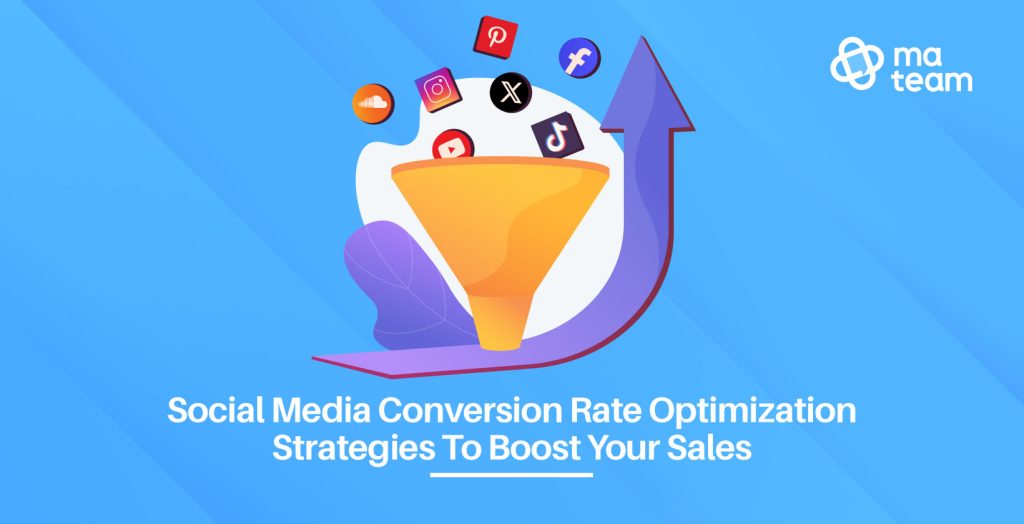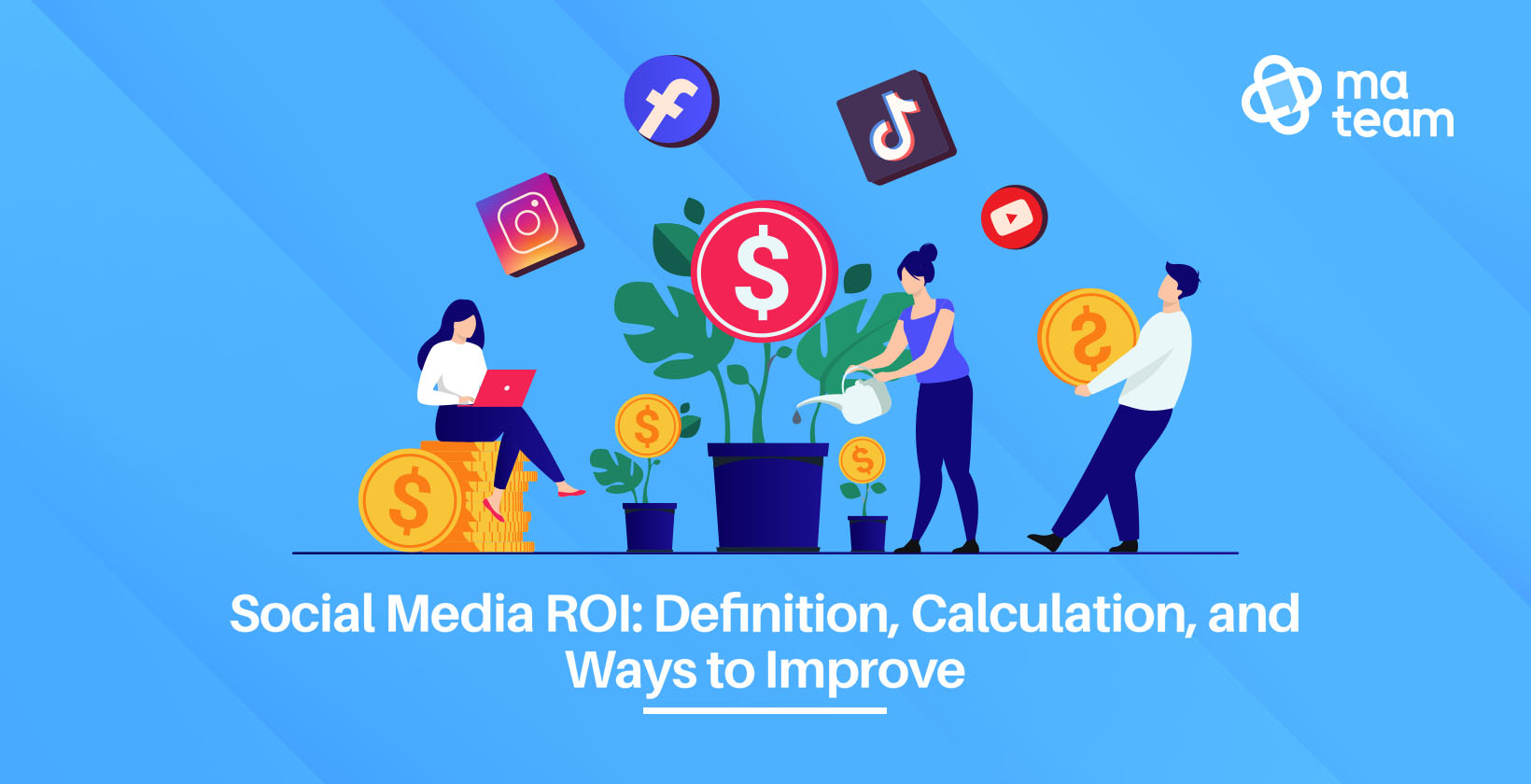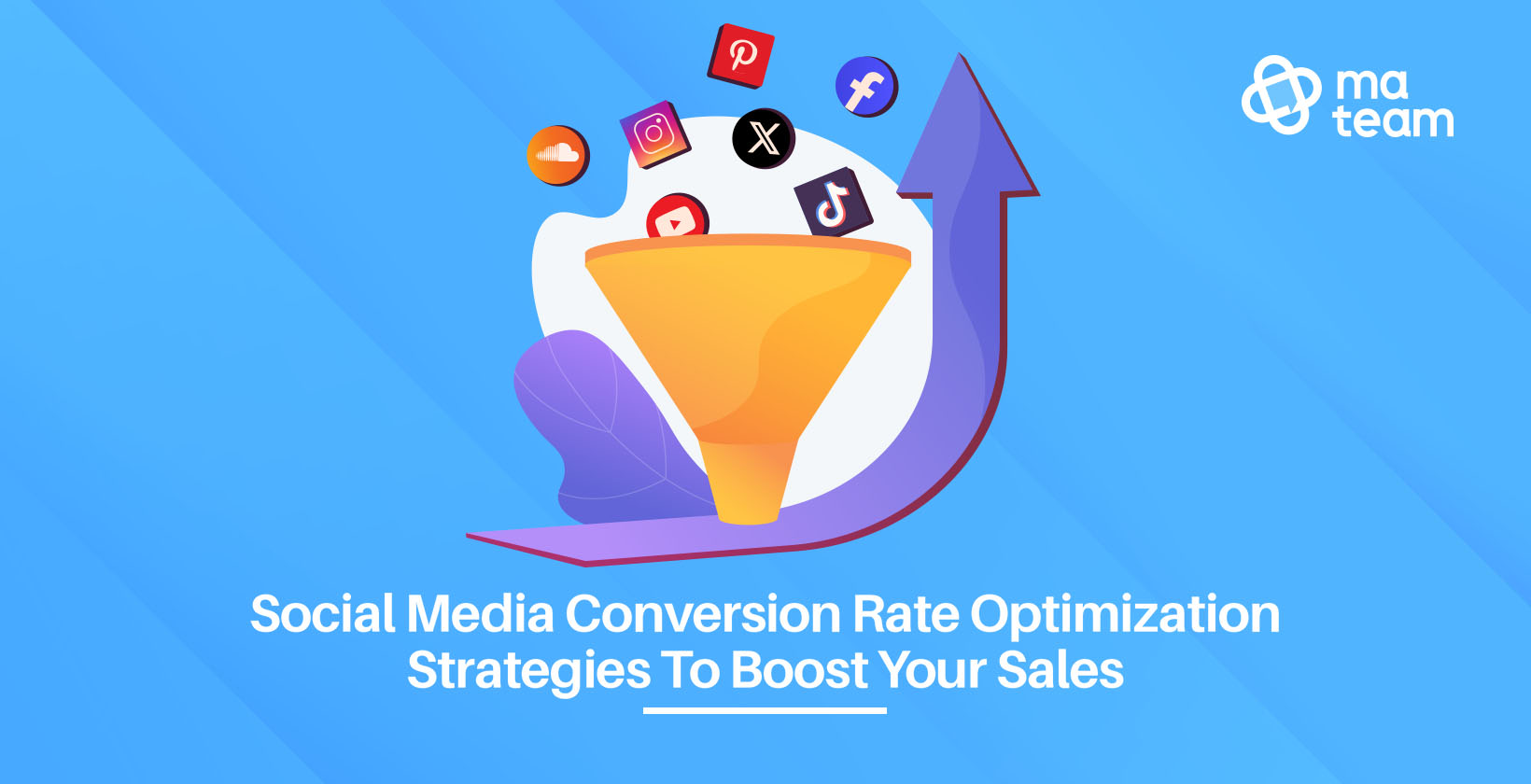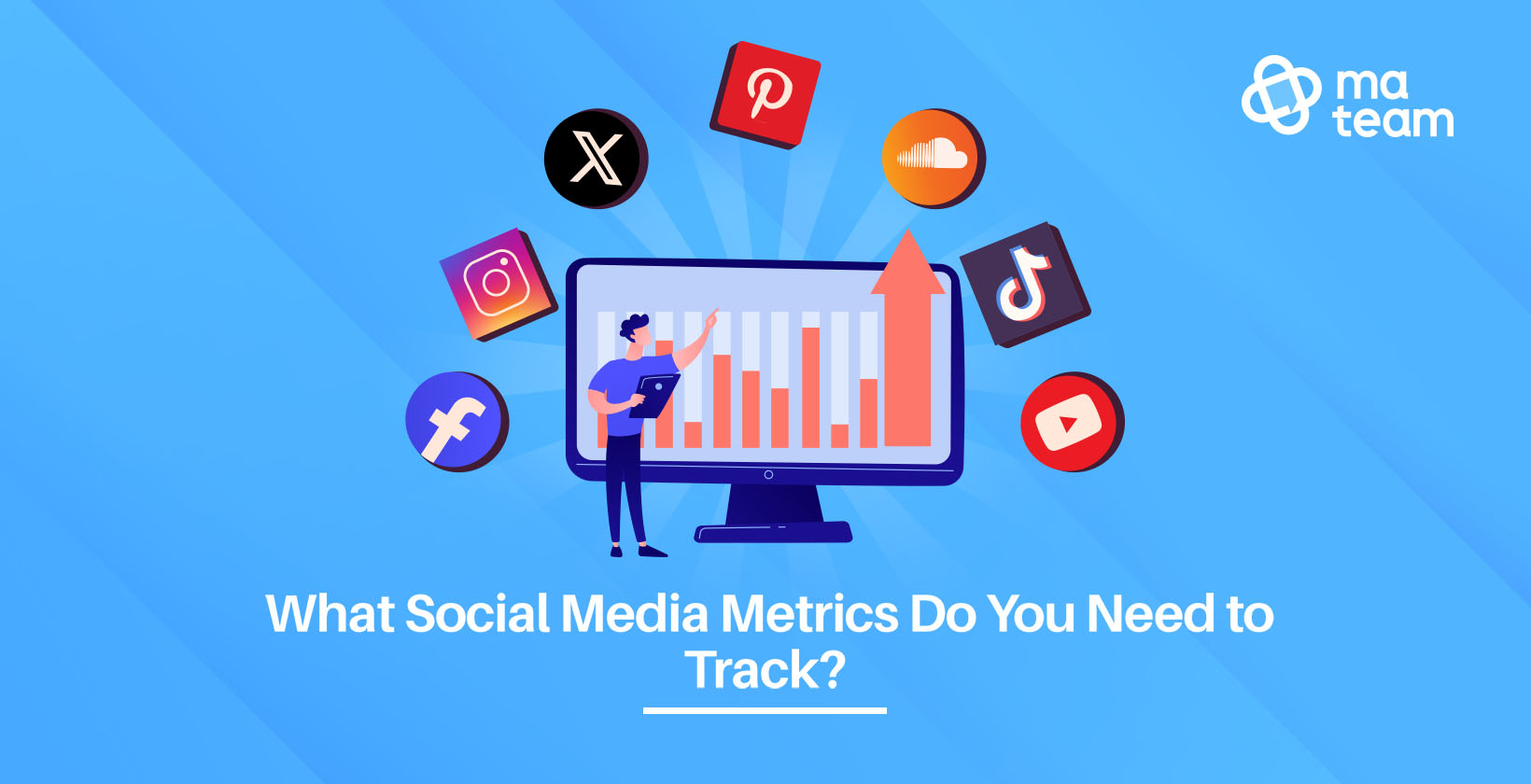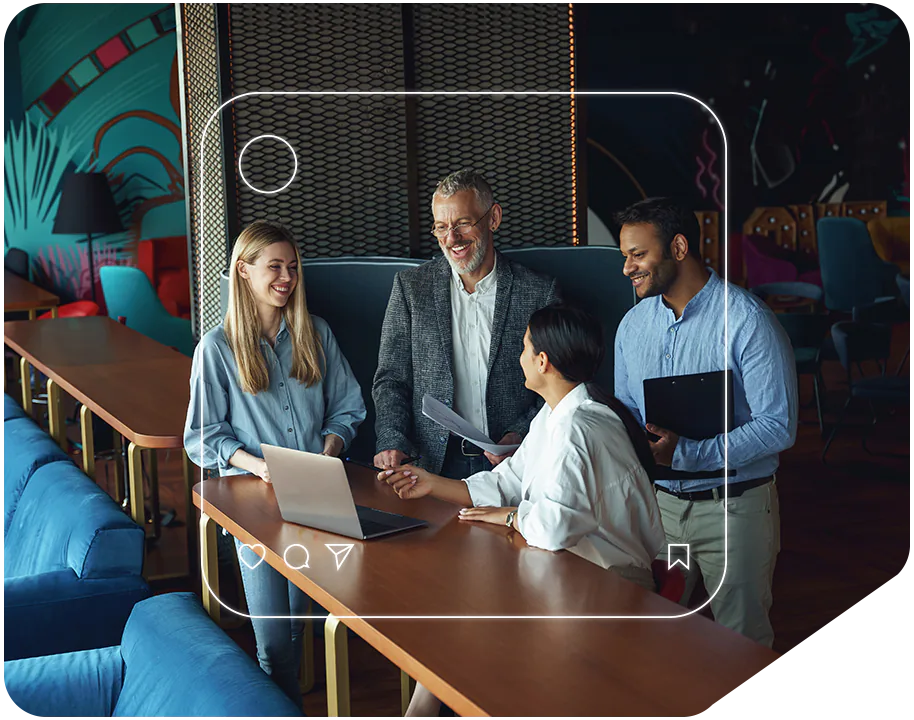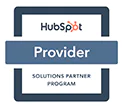Conversion rate optimization (CRO) on social media involves refining and enhancing various elements of your social media strategy to drive more desired actions from your audience. Whether it’s making a purchase, signing up for a newsletter, or engaging with your content, optimizing conversion rates ensures that your social media efforts translate into tangible business outcomes.
In its essence, CRO is about understanding your audiences’ needs and behaviors and optimizing your content to provide a user-friendly experience that motivates them to take action. This can involve different strategies, from crafting compelling ad copy and improving website navigation to testing different aspects of your campaign to see what resonates with your audience.
For any business, large or small, the importance of Social Media CRO cannot be overstated. It serves as the linchpin between social media activities and actual conversions, ensuring that the time, effort, and resources invested in social media marketing yield quantifiable returns. In an era where user attention is fleeting and competition is fierce, the ability to optimize conversion rates on social media directly impacts a business’s crucial goals.
Boosting Social Media CRO means understanding how users behave on different platforms. This includes creating interesting content, making easy-to-use interfaces, and leveraging data-driven insights. Seeing the value in every interaction, from powerful ads to smooth user experiences, creates a compelling journey for users, leading them to convert.
Measuring data is integral to the Social Media CRO process. Understanding which metrics matter and how to interpret them gives you the necessary feedback loop for refinement. Metrics such as click-through rates, conversion rates, and engagement metrics offer insights into user interactions, allowing businesses to tailor their conversion optimization strategies based on real-world performance.
What is the social media conversion rate?
Conversion rate is the percentage of users who take a specific action, like making a purchase or signing up, in response to your social media content. It’s a key metric showing how effective your social media strategy is in turning viewers into active participants.
Conversion can be any action you want users to perform, like making a purchase, subscribing to a newsletter, submitting a form, scheduling a call, or downloading an ebook.
To calculate the conversion rate, divide the number of conversions by the number of people engaging with a certain piece of content. For instance, if you had 30 conversions from 750 interactions, your conversion rate would be 4%.
Conversion rates vary depending on industries, categories, and social media channels, but in most cases, conversion rates between 2-5% are considered successful. A higher conversion rate means your content resonates well with your audience and encourages more meaningful interactions.
What is conversion rate optimization (CRO)?
Conversion rate optimization (CRO) is the process of increasing the number of users who perform a desired action on a social media platform or a website. At its core, CRO is about enhancing user experience, and that’s what your CRO strategy should revolve around.
CRO involves fine-tuning your social media strategies to encourage more of your audience to take the desired actions, whether it’s making a purchase, signing up for a newsletter, or engaging in any predefined activity. In simpler terms, it’s the art and science of improving the effectiveness of your social media efforts.
Boosting CRO involves understanding your audience, refining your content, and optimizing user experiences. It’s about creating a seamless journey for your audience, making it so enticing and intuitive that they can’t resist taking the desired actions.
In essence, CRO in social media is the difference between having a large audience and having an engaged, action-taking audience. It’s about turning social media interactions into meaningful conversions that contribute to the growth and success of your business.
What is the importance of conversion rate optimization in social media?
The importance of CRO lies in its ability to maximize the value of every visitor or follower on your social platforms. Conversion rate optimization (CRO) is all about increasing the percentage of your audience who take a desired action, whether it’s making a purchase, signing up for a newsletter, or any other predefined goal.
Instead of merely attracting attention, CRO ensures that the attention translates into measurable results. It’s about making every marketing dollar count by optimizing conversion and generating more value from your social media campaigns.
In a vast digital landscape, standing out is essential. A well-executed CRO strategy sets you apart by delivering a user experience that resonates with your audience, fostering loyalty and trust, which is crucial for growing and retaining your audience.
What are the 16 strategies to boost your conversion rate on social media?
The 16 strategies to boost your conversion rate on social media include those listed below.
- Audience segmentation
- Message personalization
- Landing page optimization
- Clear call-to-action (CTA)
- Social media post optimization
- Tracking social media analytics and insights
- Boosting your content with social ads
- Optimizing content for the target audience
- Using social proof (reviews, testimonials)
- Leveraging user-generated content (UGC)
- Using consistent branding across channels
- Building partnerships with content creators
- Implementing retargeting campaigns
- Offering value-driven lead magnets
- Nurturing your leads with automated email sequences
- Optimizing the checkout process
1. Audience segmentation
Audience segmentation is a method of analyzing your target audience to improve customer experience based on their behavior, demographics, psychographics, and their feedback.
Audience segmentation is critical for getting to know the habits of your audience and predicting their behavior on social media or your website, allowing you to tailor your social media conversion rate optimization strategy accordingly.
Segmenting your target audience is a strategy that involves analyzing various aspects like visited pages, time spent, return frequency, and the user’s position in the conversion funnel.
This analysis uncovers patterns and trends, revealing the interests, goals, and challenges of distinct user groups. For example, you can categorize users who abandoned carts, those who completed purchases, free trial sign-ups, or those utilizing specific features.
This approach allows you to target only those users who are most likely to engage with your content or your ads and to optimize your pages based on user behavior.
2. Message personalization
Message personalization is the practice of customizing marketing messages to match the unique interests, needs, and behaviors of individual users. This process involves gathering and categorizing customer data.
Message personalization across social media channels helps build loyalty, increase customer lifetime value, and maximize conversions. Brands usually apply this approach to personalized products, offers, and cross-sells to increase the chances of generating more quality leads, improve audience retention, and boost conversions.
Your social followers, email subscribers, and organic traffic may overlap, but they differ in brand awareness. Each platform, like Instagram or LinkedIn, calls for distinct messaging styles—informal on Instagram and formal on LinkedIn.
Social media messaging includes posts, captions, comments, and DMs, while marketing messaging conveys the brand mission at scale. Personalized messaging is a marketing practice that nurtures trust, affinity, customer retention, and brand loyalty and makes your existing and potential customers feel valued.
To stand out and ensure clarity, scrutinize each element, aligning them with your brand’s personality. This practice not only distinguishes you but also guides your content strategy. Understanding the nuances of social messaging, marketing messaging, and brand voice is crucial for effective communication.
3. Landing page optimization
Landing page optimization is the process of adjusting the method of refining a webpage’s layout and content to improve user experience. It’s about making the landing page easy to navigate on all devices, having a clear CTA, and making it visually appealing.
Think of the landing page as your store window – your goal should be for customers to enter that store and take action right after seeing the window display. You can do this by focusing on the visuals, layout, clear and relevant headings, and, of course, creating top-notch content. Crafting relevant headings and appealing CTA on your landing pages will help make the journey to a conversion straightforward and effortless.
Landing page optimization is also crucial for boosting lead generation and conversions, and it’s an integral part of social media CRO. By creating a landing page that compels your audience to take action, you are significantly improving your chances of increasing conversions. Focusing on optimizing landing pages for conversions can lead to an average conversion increase of 2.35% across various industries, according to OptinMonster Landing Page Conversion Rate Statistics.
If you are unsure which landing page version will resonate better with your target audience, you can always run A/B testing for your landing page and let the figures direct your decision based on your audience’s preferences.
4. Have a clear call-to-action (CTA) /Clear call-to-action (CTA)
Having a call-to-action (CTA) is the necessary step in turning engagement into conversions by prompting users to take the desired action. A well-defined CTA, whether it’s to make a purchase, sign up, or download, eliminates ambiguity for the audience. It provides a clear pathway, streamlining the user journey and enhancing the likelihood of conversion.
When optimizing your CTA as a part of CRO strategy, the focus is on making the message clear and clutter-free, emphasizing the urgency to respond, using keywords that work with your audience, and offering value behind a simple message.
Additionally, you can use conversion rate tools such as heat maps, A/B testing, or analytics to test the performance of your CTA and identify what needs improvement. CTA is also often optimized based on user feedback, making it even more compelling and more likely to prompt users to take action.
Without a clear CTA, users may be uncertain about the next steps, leading to missed opportunities. A concise and compelling CTA serves as a prompt, aligning user intent with business goals. It not only boosts conversions but also contributes to a seamless and positive user experience, fostering trust and satisfaction in the long run.
5. Optimize your social media posts with A/B testing
A/B testing, or split testing, is one of the basic CRO methods of comparing two versions of a piece of content or a landing page to see which one gets a better audience response, allowing data-driven decisions.
By dividing the audience into two groups and testing different elements such as headlines, visuals, or captions, you gain insights into what engages your audience effectively. This process refines your content strategy, ensuring that your posts are tailored to audience preferences, increasing the likelihood of conversions.
It’s a continuous improvement cycle where you adapt your content based on real-time feedback, optimizing your social media presence for maximum impact on your conversion goals.
Measuring A/B testing results involves analyzing key performance indicators (KPIs) to determine the impact of variations on your desired outcomes. Start by focusing on the specific metrics relevant to your A/B test, such as click-through rates, conversion rates, engagement metrics, or any other goals you set for the test.
6. Tracks your social media analytics and insights
Tracking social media analytics and insights is crucial for CRO because it provides valuable data for refining your strategy and improving user engagement. Analytics reveal user behavior, helping you understand which social media channels are driving traffic and conversions. By monitoring metrics such as click-through rates, engagement, and conversion rates, you can identify successful strategies and optimize underperforming ones.
Social media analytics also offer insights into audience demographics, enabling you to tailor content to specific segments. This data-driven approach ensures that your social media efforts align with user preferences, which enhances the overall conversion rate and maximizes the impact of your social media marketing efforts.
To track social media metrics effectively, you can use a combination of built-in platform tools and third-party analytics software. Social media platforms like Instagram, Facebook, and YouTube provide built-in analytics tools such as Instagram Insights, Facebook Insights, and Twitter Analytics. These tools offer insights into engagement, reach, and other key metrics specific to each platform.
For a more comprehensive analysis and to consolidate data from multiple platforms, consider using third-party analytics tools. Tools like Brandwatch, Talkwalker, and Keyhole are examples of third-party analytics software. These tools often offer advanced features, including sentiment analysis, competitor tracking, and customizable reporting, providing a more holistic view of your social media performance.
7. Boost your content with social ads
A carefully planned ad campaign can be a game changer for your CRO strategy. You can choose between various formats to boost your content with social ads to drive conversions, including static image ads, video ads, messenger ads, story ads, collection ads, and carousel ads. Choosing the advertisement type should be aligned with your conversion goals.
For example, if your goal is to increase brand awareness and grow your following, you may opt for a post boost on Facebook or Instagram. Establishing brand recognition is an important part of CRO strategy in the long run, even if conversion doesn’t happen immediately.
However, if you want to channel your followers further down the sales funnel, you may opt for a more elaborate social ads campaign.
If your website includes advertisements, their placement and relevance should be carefully planned. Relevant, well-crafted ads can positively impact conversion rates, while intrusive or pointless ads can have the opposite effect.
Effective social media ad campaigns enhance conversion rates by generating leads and sales, and they also establish initial connections with users unfamiliar with your brand.
In essence, social media ads serve a dual purpose: driving immediate leads and conversions while fostering brand awareness for future conversions.
To measure the impact of your ads, track metrics like impressions, clicks, and website traffic. To trace users’ pathways toward conversions, consider utilizing social tracking codes or UTM parameters. These pieces of code attribute website conversions to social media interactions and offer insights into your ads’ impact on the marketing funnel.
8. Optimizing content for the target audience
Optimizing content for the target audience involves tailoring your content to your audience’s preferences and making it personalized and aligned with their needs. To drive conversions, it’s essential to make your content truly relatable and engaging for your followers.
You can utilize customer data to segment your audience and craft a targeted messaging campaign that addresses their problems, motivations, and desires. For instance, a food delivery service could create tailored email campaigns for different customer segments, such as college students, busy professionals, and busy parents, to add relevance and improve the effectiveness of their marketing efforts.
You can use different analytics tools, such as Google Analytics, to identify which products are most popular among different customer segments and then create targeted promotions based on that information.
9. Using social proof (reviews, testimonials)
Social proof is crucial for CRO strategies as it leverages the psychological phenomenon where people tend to repeat the actions of the majority and make decisions based on other peoples’ experiences.
Incorporating social proof into your content, such as customer reviews, testimonials, or user-generated content (UGC), can enhance your credibility and persuade potential customers to take desired actions, such as making a purchase or signing up. This is because social proof provides real-world evidence of the positive experiences of others, fostering trust and confidence in your brand and ultimately boosting conversion rates.
To measure how well your social proof and testimonials are doing, keep an eye on key performance indicators (KPIs) like clicks, leads, retention, sales, or revenue. Tools like Google Analytics, A/B testing, or heatmaps can be super helpful in fine-tuning your social proof and testimonials. Use the data and insights they provide to make these trust-building elements even more effective.
A/B testing is also convenient for choosing between different types of social proofs, their placements and layouts, and helping you understand which works best for your audience.
10. Leverage user-generated content (UGC)
User-generated content is unsponsored, brand-focused content created by fans or customers. It’s an essential part of CRO as it encourages others to share their experiences through reviews, images, or testimonials. When used strategically in your social posts and ads, UGC not only helps drive conversions and boost engagement but also plays a key role in building trust and brand loyalty and growing your audience.
To leverage UGC effectively, actively encourage your audience to contribute. Ask for reviews, run contests, or create dedicated hashtags. Incorporate this content into your social media strategy—share it in posts, stories, and ads.
UGC fosters a sense of community, building trust and loyalty. Track metrics like clicks, shares, comments, and social share of voice (SOV) to measure the impact and refine your strategy accordingly.
11. Using consistent branding across channels
Using consistent branding across channels means making your brand unique and easily recognizable for your target audience.
Start creating your brand’s unique visual and content identity by crafting a comprehensive brand style guide. Clearly outline guiding principles, goals, and values. Employ a consistent color palette and establish a posting strategy that resonates with your brand voice and aligns with your audience’s preferences.
Using the same logo, color scheme, and messaging across channels helps users easily identify your brand. This visual and thematic continuity builds a sense of reliability, which is crucial for converting social media interactions into meaningful actions, like conversions or purchases.
12. Build partnerships with content creators
Building partnerships with content creators helps establish brand credibility and boost visibility, grow audience, and drive traffic to your social channels, resulting in more leads and conversions.
It’s a brilliant, cost-effective way to promote your content, product, or service. Instead of spending a fortune on ad campaigns, consider partnering up with other reputable content creators in your industry or utilizing influencer marketing to spread the word about your brand.
Metrics to assess the impact of the brand partnership include reach, conversion rates from influencer-generated content, social media audience growth, and the overall increase in website traffic originating from social platforms. Analyzing these metrics provides insights into the effectiveness of the partnership and whether it successfully converts engagement into tangible actions.
13. Implementing retargeting campaigns
Implementing retargeting campaigns boosts conversion rates by re-engaging an audience who has shown interest in your brand in the past but skipped the conversion. This strategy involves displaying paid online ads based on a user’s activity on your website or social media profiles.
Retargeting is a powerful CRO strategy that engages individuals who have interacted with your brand but didn’t convert. By placing a cookie on a user’s browser after specific actions like website visits, it displays targeted ads during web browsing or social media use, aiming to prompt the user to convert.
The advantage is clear: retargeting focuses on those already interested, making them a valuable audience. If engagement doesn’t deliver enough conversions, retargeting could be the way to go. For many users, this second attempt to motivate them by displaying additional ads is often the tipping point toward conversion.
14. Offer value-driven lead magnets to your audience
Offering value-driven lead magnets to your audience means enticing them with something of value in exchange for their contact information. For example, samples, free tools, free trials, infographics, free classes, templates, etc.
Also, long-form content, like in-depth blog posts, is often employed as a powerful lead magnet. These comprehensive articles offer valuable insights tailored to your target audience, motivating users to share their information in exchange for access to the content.
Use eye-catching visuals and catchy but meaningful captions to make your lead magnet even more captivating. Finally, share your lead magnet across all relevant channels, including emails and social media platforms.
Effective lead magnets should be tailored to address specific pain points or interests of your target audience, making them more inclined to engage with your brand and eventually convert. This strategy not only augments lead generation but contributes significantly to the overall success of your social media CRO efforts.
Measuring the success of your lead magnet is relatively simple. To calculate the conversion rate from a particular lead magnet, divide the number of people who provided their contact information as a reaction to your lead magnet by the total number of visitors to your lead magnet.
15. Nurturing your leads with automated email sequences
Nurturing your leads with automated email sequences proves to be a potent strategy for transforming them into clients. By delivering value, fostering trust, and incorporating meaningful calls to action, you can effectively steer your leads toward the subsequent stages of the conversion journey.
To grab your leads’ attention and ensure they open and read your emails, nailing the subject lines is essential. Testing various versions is the key to unlocking what truly clicks with your audience. Play around with length, tone, personalization, urgency, or highlighting benefits. By experimenting, you’ll discover the formula that makes your leads want to click and explore more.
To measure the success of your lead nurturing strategy, track metrics such as Email clickthrough rate, Number of form fills or downloads, number of signups, number of emails opened, number of emails sent, email open rate, and lead score.
The goal of this CRO strategy is to gradually guide your leads toward becoming clients. Providing your prospective clients with a gradual stream of email content over time is an effective way to keep them interested in your brand.
16. Optimize the checkout process
Checkout process optimization is a step most e-commerce include in the social media conversion rate optimization strategy. The goal of checkout optimization is crafting a seamless and effortless buying experience that customers are not only motivated to share their positive encounters but are also eager to return in the future.
Consider these key aspects to enhance user-friendliness:
First, prioritize flawless functionality across all devices, emphasizing mobile optimization for a universally accessible experience.
Minimize distractions, like pop-ups, flashing banners, and ads, and create an aesthetically pleasing and inviting layout to encourage users to keep browsing.
Second, cultivate brand reputation and trust by eliminating any hidden fees and surprise costs and avoid asking users to provide unnecessary information.
To drive more conversions, it’s also important to ensure accessibility for all potential customers by offering a diverse range of payment methods.
Finally, you can simplify the purchase process further by allowing guests to checkout without the obligation of signing up or creating a profile. This user-centric approach ensures a smoother journey from product discovery to making a purchase.
How to calculate the conversion rate?
To calculate the conversion rate, start by defining what conversion means for you and your business. The basic formula for calculating the social media conversion rate is:
Social media conversion rate = (number of conversions / total audience) * 100
Conversion can be any desired action, ranging from making a purchase, subscribing to a newsletter, submitting a form, or scheduling a call.
However, the conversion rate varies between campaigns but consistently measures the effectiveness of your marketing efforts and content. By tracking this metric, businesses can assess the impact of their efforts in driving user actions and achieving marketing goals.
What metrics should you track to measure conversion rates?
There are several crucial conversion rate metrics you should measure to see if you’re reaching your goals, including:
- Cost per conversion (CPC)
- Return on investment (ROI)
- Click-through rate (CTR)
- New visitor conversion rate
- Returning visitor conversion
- Average time on site
- Bounce rate
Monitoring and measuring CRO with media metrics unveils the points on your page or in your content where visitors either convert or face obstacles. This enables you to guarantee that your design, messaging, and marketing efforts guide users effectively toward accomplishing the intended conversion actions.
What tools can help you optimize social media conversion rate?
There is a variety of free and paid tools and add-ons that can help you optimize social media conversion rates by providing insights, automating processes, and facilitating A/B testing. Here are some notable tools:
Google Analytics: A comprehensive analytics tool that helps track user behavior, conversion data, and more. It provides valuable insights into user interactions with your website.
Hotjar: Offers heatmaps, session recordings, and surveys to understand how users interact with your site, helping you identify areas for improvement.
Optimizely: A powerful experimentation platform that enables A/B testing, allowing you to experiment with different variations to find the most effective elements.
Unbounce: A landing page builder that facilitates easy creation and A/B testing of landing pages to enhance conversion rates.
VWO (Visual Website Optimizer): A versatile platform for A/B testing, split URL testing, and multivariate testing to optimize website elements.
Kissmetrics: Focuses on customer analytics, allowing you to understand user behavior and optimize conversion paths.
Choosing the right combination of these tools based on your specific needs and goals can significantly contribute to optimizing your social media conversion rate.
How does a social media agency help you increase your social media conversion rate?
Social media agencies help you increase your social media conversion rate by employing data-driven insights to understand user behavior, preferences, and engagement patterns. By analyzing metrics like click-through rates, conversion rates, and audience demographics, they can tailor campaigns to resonate with your target audience and encourage desired actions.
Furthermore, agencies often implement A/B testing to refine strategies, identifying which content, ad creatives, or posting schedules yield the best results. Using social media services ensures that this iterative process effectively optimizes your social media presence for maximum conversion impact.
Moreover, social media agencies leverage the latest tools and technologies to track and analyze performance metrics in real-time. This allows for agile decision-making, timely campaign adjustments, and continuous conversion rate improvement.
In essence, partnering with a social media agency provides a comprehensive and dynamic approach to enhance your social media conversion rate, ensuring that your brand not only reaches a wider audience but also effectively converts engagement into valuable actions.
How does the social media conversion rate impact social media advertising?
The social media conversion rate plays a pivotal role in determining the effectiveness of social media advertising. It directly reflects the percentage of users who take the desired action. Put simply, a higher conversion rate indicates that there are more conversions, and more conversions bring more profit to a business.
A high conversion rate indicates that the advertising strategy is resonating well with the audience, leading to a positive return on investment (ROI). It signifies that the ad content, targeting, and messaging are aligned with user expectations and preferences. On the contrary, a low conversion rate may signal areas that need improvement in the ad campaign.
Additionally, monitoring social media conversion rates provides valuable insights for refining advertising strategies. It helps in identifying what elements of the campaign are working effectively and what aspects might require adjustments. This data-driven approach enables advertisers to optimize their content, targeting parameters, and overall approach, ultimately enhancing the efficiency of their social media advertising efforts.
Put simply, a solid social media conversion rate is indicative of successful advertising, while a low rate prompts you to reassess and refine your strategies for better engagement and conversion outcomes.
How to determine your target audience?
To determine your target audience, start by defining so-called buyer personas and conducting social media research to discover which social media platforms are most visited by the target group.
Buyer personas represent your ideal customers and include information like age, gender, location, interests, challenges, and motivations. These fictional characters serve as a guide for your marketing efforts. Another thing you can do to help you understand who your ideal customers are is to monitor your existing customer base and your competitors’ audience. This can provide insights into the audiences’ preferences and predict their behavior, making social media conversion rate optimization more effective.
It’s equally important to utilize social listening, in other words, to monitor social media channels for discussions related to your industry and understand what problems your audience is trying to solve and how they communicate. Social listening tools can help you gather more valuable data about your target audience that you can use for your CRO strategy.
Finally, leverage analytics tools on your website and social media platforms. Platforms like Google Analytics and social media insights offer data on the demographics and behavior of your audience. Use this information to refine your social media strategy.
Regularly revisit your target audience strategy to ensure that it remains aligned with trends in consumer behaviors and the current social media landscape.
How can you reduce the bounce rate on your landing page?
To reduce the bouncing rate on your landing page, go the extra mile to make your landing pages visually appealing, easy to navigate on any device, current and relevant, and with a clear call-to-action CTA. This means making the journey to conversion easier for your new and returning visitors. When visiting your landing page, your audience should immediately recognize what action they are expected to perform without making them pressured to do so.
Avoid turning your landing pages into a guessing game for your audience. Encourage them to stay, explore, and feel that performing the desired action aligns with their visit, whether it’s downloading your app, completing a contact form, subscribing to your newsletter, or making a purchase. Creating an intuitive and engaging experience will not only reduce bounce rates but also increase the likelihood of visitors converting on your landing page.
